Bing Overseas Studies-Jasper Ridge’s BIO 105-Dirzo Lab: A Stanford Educational “Triangulo Virtuoso”
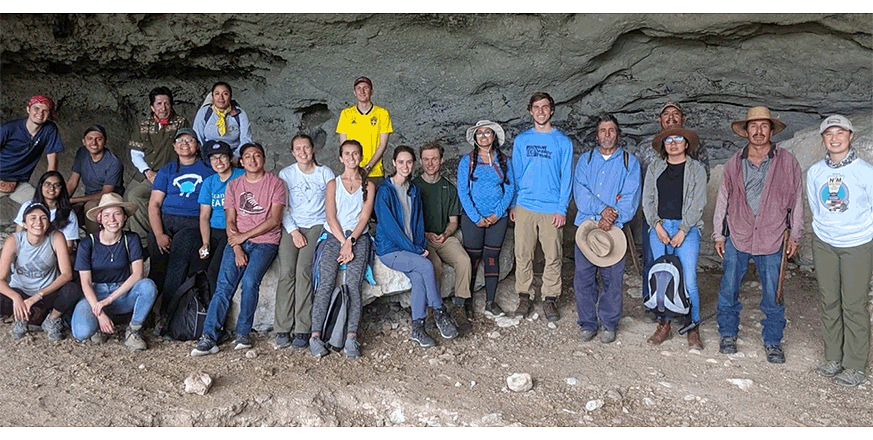
In these turbulent times of environmental and social unrest, rigorous study, personal (and collective) appreciation, and active protection of our planet’s beautiful biological and cultural diversity, can serve as critical tools to help us address the increasingly steep trajectory of such crisis. Globally and regionally much damage has been done, but there is still much action that we can take in the name of reversing this harm. In this massive venture, the key elements are diversity, solidarity, and reaching out across traditional intellectual and social silos. Luckily, Stanford provides opportunities to engage faculty and students from several entities and academic programs within the University, and with partnering institutions and communities from other nations to create relevant, formative educational synergies. The BOSP Biocultural Diversity and Community-Based Conservation (BCD) class is an example of such synergies, in this case a virtuous triangle (“Un Triangulo Virtuoso”) conformed by the Bing Overseas Studies Program (BOSP), the Jasper Ridge Biological Preserve (JR) and the Biology Department’s Dirzo Lab.
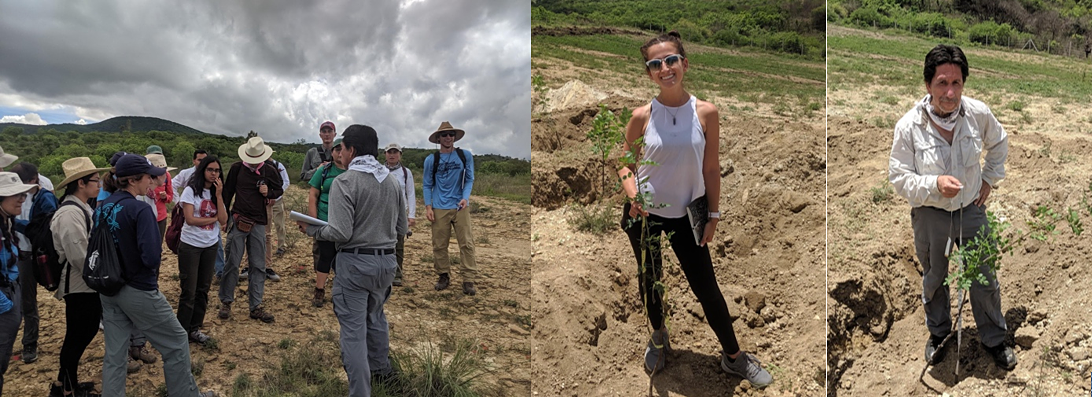
BCD course preparing to plant copal trees and Gabriela and Rodolfo with the trees they planted to support the local community’s efforts to maintain this resource.
Linking knowledge across borders, ecosystems, and labs
BOSP aims to help students “to become more adept at cross-cultural communication and international problem solving”. JR is a celebration of biological diversity immersed within urban development—a short hike through the preserve will reveal its diversity of ecosystems, species, and life forms, all residing in the ancestral lands of the Muwekma Ohlone nation. JR also features active research, educational and GK-12 outreach programs for different groups, including multi-ethnic and underserved populations. A historical and emblematic educational effort is the Biology/Earth Systems class Ecology and Natural History of Jasper Ridge Biological Preserve (BIO 105/ESYS 105). The Dirzo Lab focuses on the scientific study of ecological and evolutionary dynamics of biological diversity, the threats to its survival, and its significance for human wellbeing, as well as the role of traditional (indigenous, rural) peoples in maintaining the livelihood of biological richness. The contribution of these three entities splendidly aligned this summer as a group of 15 undergraduate students, including many BIO 105/ESyS 105 alumni, joined us on an exploration of biocultural diversity in Mexico for a month-long overseas seminar course.
The Biocultural Diversity and Community-Based Conservation journey begins!
Our course began in Mexico City where we partnered with the National University of Mexico and the National Commission for Biodiversity. Here we learned about the genetic and ecological basis of plant domestication, and the sophisticated algorithms needed to create and use databases on biodiversity. The majority of our time was spent in Oaxaca where we partnered with Universidad Sierra de Juarez and Santo Domingo Botanical Gardens. These partners, together with Oaxaca’s exuberant biological and cultural diversity, provided an ideal venue for us to more deeply appreciate, learn about, and become enamored with two fundamental attributes of our planet: bio-diversity and ethno-diversity. But our quest and challenge was not to examine these two diversities as independent entities. Instead, we aimed to understand how they have evolved through millennia of reciprocating interactions—a veritable coevolution of humans and nature. Indeed, the bio-cultural diversity in Oaxaca represents a coevolutionary process that has led to spectacular archeological sites (Montealban, Mitla), beautiful dry forest ecosystems (e.g., Guila Naquitz), conifer forests (Ixtlan) and cloud forest (Comaltepec) reserves maintained under inspirational community-based conservation programs, diversified agro ecosystems (“milpas” with multiple races of maize, beans, squashes, quelite herbs, chayotes, guaje trees, and even edible grasshoppers or “chapulines”), and sustainably managed forests (Calpulalpan, Ixtlan).
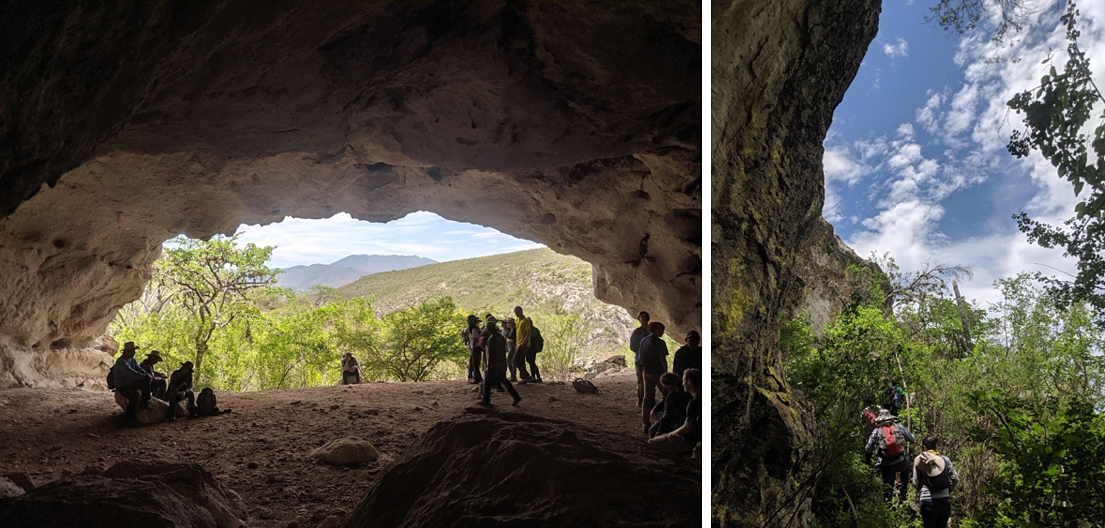
Guila Naquitz cave - the first known site of the domestication of maize and students hiking through a dry forest ecosystem.
In Oaxaca we learned about BCD via observations at each of these amazing sites and through the lessons and perspectives of our gracious Zapotec interlocutors. This occurred, for example, when they guided us through their sites to get to know the actual cave where their ancestors domesticated –for the benefit of humanity– maize, squash and many other crops for the first time (6,000-10,000 years ago—the Mesoamerican genesis of agriculture). Another such example was when they engaged us in exciting conversations, as they showed us how the enigmatic “cochinilla” (cochineal) insect was simultaneously domesticated with its food plant, the Opuntia cactus, to develop the spectacular red scarlet dyes, and how they combine it with other organic dyes to color –and give life to– amazing carpets, shawls, table cloths or blouses.

The “cochinilla” (cochineal) insect is domesticated with its food plant, the Opuntia cactus.
They also shared with us the sophisticated art of wood carving and painting to engender art work of dazzling whimsical figures (the internationally famous “alebrijes”). Similarly, they guided us in a hike through their dry forests with spectacular petrified cascades and pools, and discussed with us the challenges of maintaining those natural tourist-attractive treasures while maintaining their place, language, culture and traditions. Furthermore, they explained to us how their governance system of “usos y costumbres” has engendered a cohesive community of “comuneros” (collective land owners) that sustainably manage their resources (e.g., timber), use the revenues to support the infrastructure and services of their towns, and re-invest profits in the management of their resources.
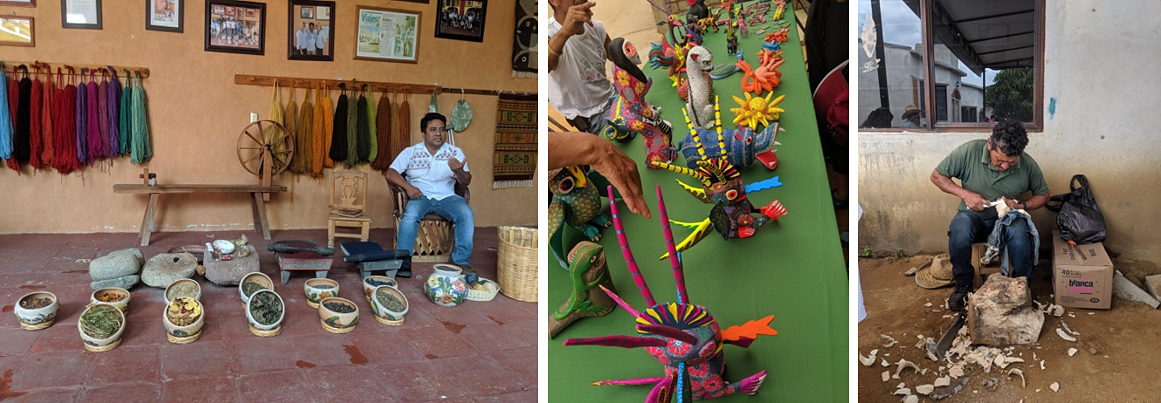
A demonstration on natural dying by a world renowned zapotec artist and Alebrijes on display & being carved in a demonstration.
Learning conservation science via hands-on experiences
Not only did we learn through the perspectives shared by our partners; we also conducted three group research projects. In one of them we, BCD, described the agro-biodiversity of the plethoric municipal market of Oaxaca City, addressing questions such as: what is the magnitude of food items available in a market of this type; what proportion is domesticated or collected directly from the wild; what is the genetic diversity present in some of the most common cultivars (e.g., chiles, avocados, maizes); to what extent does a mega-diverse market include products that originated elsewhere vs native ones. A second project examined the status of conservation of the dry forest and the regeneration potential of the trees used for the production of alebrijes—and we also contributed to the planting of trees of this species. In the third project, we investigated the consequences of two types of forest management for the conservation of overall plant diversity in managed forests. For these projects we used rigorous sampling protocols and conducted the appropriate analysis of data. The BCD students used these materials to prepare presentations that were shared with students from the Sierra de Juarez university, while they shared their research projects with us and graciously enriched our spirits with their beautiful performance of local dances—a veritable intercultural exchange! The BCD students also wrote up the results in the form of scientific publications. Gabriela and I will be translating these papers and will share them with the communities where BCD conducted the work. We hope this will be a modest token of appreciation for the immense benefit we all derived from the experience of interacting with our local partners.
Strengthening the network of community and knowledge
In the 2019 edition of the BCD course the potential for interdisciplinary, across-Stanford-programs to morph into an educational “triangulo virtuoso” became vividly materialized. BOSP provided the guidelines and inspiration for us, instructors, to design the course, as well as the necessary support (financial and logistic), both on campus and overseas. BOSP’s now recognized BCD course attracted several alumni of JR’s BIO 105/ESyS 105. These alumni, having had the sound training on ecology, natural history and collective learning that this class provides, played a significant role in supporting the rest of students throughout the course. The Dirzo Lab developed the contents and learning goals, as well as the scientific and pedagogical concept and design, and arranged the involvement and recruitment of the local partners in Mexico City and Oaxaca. As an additional highlight, this year we had the fortune of including two local students from a Maya community of the Yucatan Peninsula as students in the course. This added a splendid element of diversity to our class which greatly benefited all of the students. Gabriela and I hope this educational exercise may contribute to preserving our wondrous but globally threatened biocultural diversity.
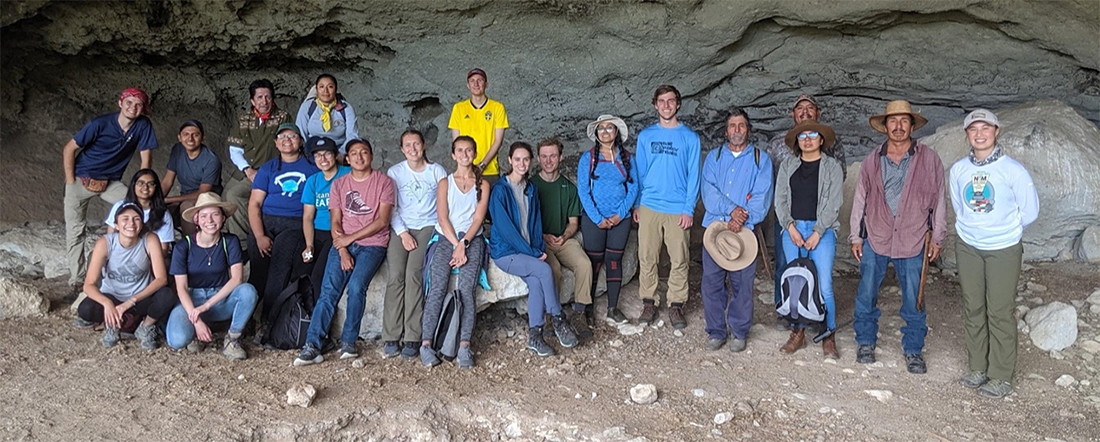
The 2019 BCD class and some of our local guides at Guila Naquitz cave.
Pictures by Gabriela Esther Nagle-Alverio.
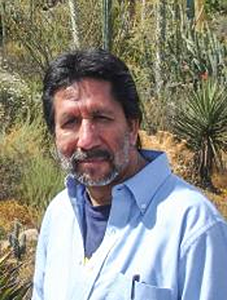
Rodolfo Dirzo Senior Fellow Bing Prof in Environmental Science and Senior Fellow at the Woods Institute for the Environment Humanities and Sciences.
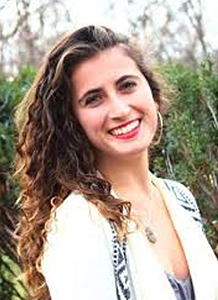 Gabriela Esther Nagle-Alverio (Stanford Alum and BIO 105 alumn class of 2018). Grabriela also produced a podcast about what makes Jasper Ridge special: https://soundcloud.com/fasterbabe/jrbp
Gabriela Esther Nagle-Alverio (Stanford Alum and BIO 105 alumn class of 2018). Grabriela also produced a podcast about what makes Jasper Ridge special: https://soundcloud.com/fasterbabe/jrbp



